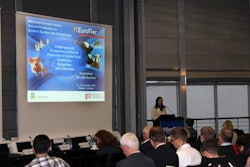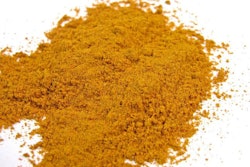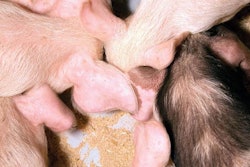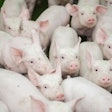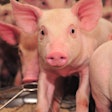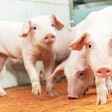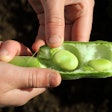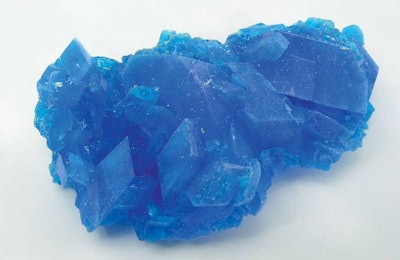
This article appears in the May/June issue of Pig International. View all of the articles in the digital edition of this magazine.
Long before the advent of zinc oxide, another mineral used to dominate piglet feeds: copper sulphate. It was known to reduce or prevent piglet diarrheas and, as such, it improved animal growth rate and feed efficiency. Indeed, when antibiotics called for a rotation from batch to batch, copper sulphate remained a constant addition to even the simplest corn-soybean meal-type diets. With the introduction of zinc oxide, the effects of copper sulphate appeared to wane, but it never completely left the scene, mostly because it is very inexpensive.
Original research findings
Copper is not a benign metal. It can quickly become toxic, especially when feed intake is high. As the latter is never high enough in post-weaned pigs, relatively high concentrations are tolerated for short periods of time. Thus, for the nursery phase (weaning to 20 kg body weight) piglet diets were fortified with up to 250 ppm copper from copper sulphate (it had to be copper sulphate, although later research findings have indicated other possible copper sources). Beyond this, level toxicity was becoming evident. Thus, the first feed post-weaning was fortified with 250 ppm copper, whereas the second and third one were given lower quantities, for example 200 and 150 ppm, respectively, only to avoid possible toxicity. It was not uncommon to find diets with 250 ppm copper in all three diets, up to 20 kg body weight.
The main reason for using borderline levels of a potentially toxic compound was due to the fact that it continued to give linear improvements in performance up to such level. Thus, anything less was considered wasted potential. Of course, toxicity was always possible if pigs exhibited unexpected high feed intakes, but, up until the advent of modern piglet formulas, this was exceptionally rare.
Current practice
Supplementing piglet diets with high dosages of zinc oxide is under pressure worldwide. In the European Union, however, which has imposed an otherwise restrictive feed legislation, it is common practice to add pharmacological doses of zinc oxide, but only under veterinary prescription. Even in the U.S., this ingredient is under scrutiny, along with growth-promoting antibiotics. Luckily, long experiences in the EU have demonstrated that we can replace both antibiotics and high dosages of zinc oxide. This is done through feed reformulation and the use of alternative additives. One of those is, naturally, copper sulphate; old technology at the rescue due to new regulations!
But, there is a limit to how much copper can be added in a piglet feed — more or less for the same reasons zinc oxide has been banned, but luckily the upper limit is not that far away from being useful. Today, piglet diets in the EU can contain up to 170 ppm copper from all sources, including the 8-10 ppm originating from the natural ingredients. Thus, it is recommended to add at least 150 or so ppm copper from copper sulphate to allow copper from natural ingredients and what is provided through the usual vitamin and trace mineral premix. Some nutritionists, either unaware of the original research or fearing of overdosing copper (the nutritional needs are only about 10 ppm to begin with and most premixes provide that much, anyway) only add 50 to 75 ppm. However, this is simply not enough.
Using the correct dosage
Using just a bit of copper sulphate to be sure is not going to harm animals, but it is not going to help them either. Going back to original research, we need 250 ppm to get the full result, and at least 150 ppm to start seeing an effect. And, if we accept the hypothesis of copper sulphate being a bacteriocide, then we need the highest possible dosage exactly when pathogen pressure is highest. Unfortunately, in the EU we can use only that much.
Personal experiences
I must admit that in my own piglet feeds I provide no more than 0.5 kg copper sulphate per metric ton of complete feed. This provides a final concentration just below the limit, when taking into account the premix and natural ingredients. But even with this relatively sufficient amount, I consider myself ill served, as I would prefer to use more. After all, bacteriocides work in a dose-response model: the heavier the pathogen load, the heavier the dosage needed to counter them. But what I really don’t understand is why piglet feed makers, such as one client of mine in Canada, use only 75 ppm copper, for example, when there is no such regulation there to limit the use of this ingredients. We had a long discussion, based on which I prepared this article, and we decided that when it comes to copper sulphate as an additive, we should either use the right amount or not at all.
Copper sulphate versus zinc oxide
The mode of action for both zinc oxide and copper sulphate remain within the sphere of investigation. The most widely accepted hypothesis calls for zinc oxide to regulate gut microflora, just like growth-promoting antibiotics — that is by suppressing bacterial load in the small intestine and releasing nutrients for the host. Its pathogen elimination abilities come rather second in importance. The opposite is believed to be the case for copper sulphate, although the debate is still going on.
When it comes to copper sulphate as an additive, we should either use the right amount or not at all.
In any case, this perhaps explains why in some trials there is no additive effect, whereas in others both products appear to work together. If this holds true, zinc oxide can be considered a universal additive, whereas copper sulphate an additive that becomes of importance during severe pathogenic pressure. Perhaps this explains the lack of response to copper sulphate in diets for post-weaned pigs that are already supplemented with zinc oxide and disease preventing drugs (not just growth-promoting antibiotics). In either case, commercial practice often calls for the use of copper sulphate throughout the post-weaning period (and quite often even beyond where this is still allowed), if only because copper sulphate remains inexpensive and readily available.
Final question
One final question remains: zinc oxide is insoluble at neutral pH, but it becomes soluble in acidic environment. If we accept stomach pH in weaned pigs is nowhere as acidic as in older pigs, we can hypothesize it is the partial insolubility of zinc oxide that confers its main effect. On the other hand, copper sulfate is very soluble, and of course this might explain the different modes of action. But what would happen if insoluble sources of copper were used instead of copper sulphate?
Read more about zinc's future in pig feeds under EU regulations


